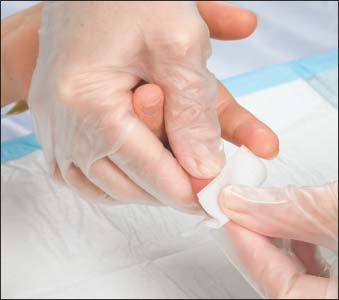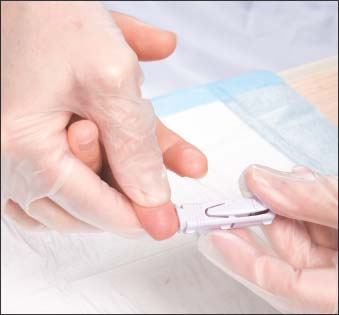Blood Glucose Monitoring
Blood glucose monitors measure blood glucose concentrations. A drop of blood is placed on a blood glucose test strip before or after the strip is inserted into the monitor. A portable blood glucose monitor provides quantitative measurements that compare in accuracy with other laboratory tests. Most monitors store successive test results electronically to help determine glucose patterns.
Equipment
Gloves ▪ portable blood glucose monitor ▪ alcohol pads ▪ gauze pads ▪ disposable lancets or mechanical blood-letting devices ▪ blood glucose test strips ▪ Optional: small adhesive bandage.
Preparation of Equipment
When using a blood glucose monitor, calibrate it and run it with a quality control test to ensure accurate test results. Most hospital-based glucose monitors must have quality control tests performed every 24 hours. Follow the manufacturer’s instructions for calibration. If appropriate, ensure that the code strip number on the test strip matches the code number on the monitor.
Implementation
Verify the doctor’s order.
Confirm the patient’s identity using at least two patient identifiers according to your facility’s policy.4
Explain the procedure to the patient.
Next, select the puncture site—usually the fingertip or earlobe.
If necessary, dilate the capillaries by applying warm, moist compresses to the area for about 10 minutes.
Wipe the intended puncture site with an alcohol pad and allow it to dry completely (as shown below).

To collect a sample from the fingertip with a disposable lancet (smaller than 2 mm), position the lancet on the side of the patient’s fingertip perpendicular to the lines of the fingerprints. Pierce the skin sharply and quickly to minimize the patient’s anxiety and pain and to increase blood flow. Alternatively, you can use a mechanical blood-letting device, such as an Autolet, which uses a spring-loaded lancet (as shown below).

After puncturing the finger, gently massage the base of the finger, stroking toward the puncture site but not squeezing the puncture site to avoid diluting the sample with tissue fluid.
Turn on the monitor.
Touch a drop of blood to the test area of the test strip; make sure the entire test area is covered.
Insert the test strip into the blood glucose monitor according to the manufacturer’s instructions (as shown below).
Stay updated, free articles. Join our Telegram channel

Full access? Get Clinical Tree


Get Clinical Tree app for offline access
